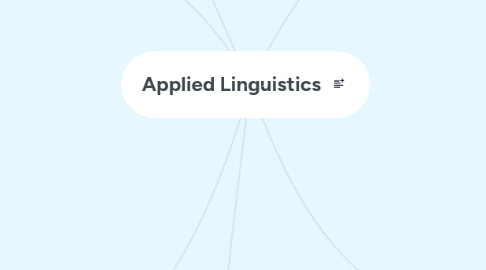
1. Pragmatics
1.1. A branch of linguistics that is concerned with the way the language is used in communication.
1.2. A linguistic trend with specific aims and research methods.
1.3. Main Features.
1.3.1. Language is considered as a discourse and text.
1.3.2. Language is mainly a means of communication.
1.3.3. The processes that take place in communicative acts are what really matters.
1.3.4. The use of language is more important than its forms.
1.3.5. Use of real and contextualized linguistic data.
1.3.6. Stands out by being interdiciplinary.
1.3.7. Special attention is paid to the usefulness and applicability of linguistics theories that may account for communicative competence.
2. The Field Of Applied Linguistics
2.1. Seeks to establish the relevance of theoretical studies of language to every day problems in which language is implicated. -Widdowson.
2.2. Branch of linguistics where the primary concern is the application of linguistics theories, methods and findings to the elucidation of language problems which have arisen in other areas of experience. -Crystal.
2.3. Applied Linguistics cover:
2.3.1. The methods and results from a branch of science into another area of knowledge.
2.3.2. The methods and results from a branch of science use to solve practical social problems.
2.3.3. The application itself.
2.4. Interdisciplinary, scientific, educational, and a problem solving activity.
3. Fields Of Study In Applied Linguistics
3.1. Language teaching & Language learning.
3.1.1. Related to the teaching and learning of a second language process.
3.2. Translation studies.
3.2.1. Deals with the transfer of linguistic information from one language to another.
3.3. Clinical linguistics.
3.3.1. Presents biological modesl and hypotheses to explain the functioning of language in our brain.
3.4. Language planning and policy.
3.4.1. Activities of intervention over linguistics practices.
3.5. Computational linguistics.
3.5.1. Tries to develop theories and techniques that serves to process natural languages into machine languages.
3.6. Ethnolinguistics
3.6.1. It is concerned with the connections existing between linguistics and a particular view of the world in a particular culture and related with communicative situations.
3.7. Sociolinguistics
3.7.1. The study of language in relation to society. -Hudson. It is primarly concerned with external factors and their effect in the language learning.
3.8. Psycholinguistics
3.8.1. Studies the language learning as a cognitive process. What goes inside the human mind during the process of acquiring language. Internal factors.
4. Reference
4.1. • IEXPRO. (2020). Methodological Approaches. Class Anthology.
5. Ferdinand Sassure
5.1. Founder of modern linguistics.
5.2. Proposed a distiction between language and parole.
5.3. Concepts in Structuralist Paradigm
5.3.1. Linguistic sign. Structure. Level. Componenet.
6. Generativism
6.1. Noam Chomsky`s work originate it.
6.2. Is in constant revision.
6.3. Idealization, intuition and introspection.
6.3.1. Language is innate and the speaker of the language possesses an innate knowledge of it.
6.4. The importance of rules.
6.4.1. Linguistic description is obtained by means of structures, levels, and components. it is focus on rules
6.5. Explanations as the main objective of the linguistics study.
6.5.1. Linguistics theories should have an integral explanatory element.
6.6. The existence of linguistics universals.
6.6.1. There are a number of features that are all in common in all languages: The formal (rules) and the substantive (content).
6.7. The creative nature of language use.
6.7.1. Language use is creative.
6.7.2. The users of the language can create forms they have never heard before.
6.7.3. All creativity is conducted within the framework of a rule.
6.8. The notions of deep, surface structure and transformation.
6.8.1. A linguistic description should provide explanations about the speaker's ability to understand and generate new sentences.
6.8.2. Surface structure.
6.8.3. A deep structure or propositions that may udergo transformations.
6.8.4. Transformations or operations that go from the deep structure to the surface structure. Allow us to see the connection between sentences.
6.9. Competence vs Performance.
6.9.1. Competence is the intuitive knowledge that every speaker possesses of the language.
6.9.2. Performance is the act of intreprating or producing a speech act.
